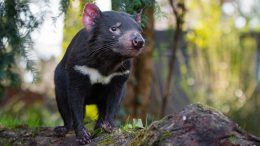“Lions and tigers and bears, oh my!”
This phrase, chanted by Dorothy, the Scarecrow, and the Tin Man as they cautiously make their way through the dark woods in the Land of Oz, echoed through my head when I learned that there are now more tigers held in captivity than living in the wilderness.
According to the Global Tiger Forum, there are around 5,500 of these big cats living free on our planet, yet in the United States alone an estimated 5,000 or more tigers live in zoos or are privately owned. Would Dorothy be as afraid today knowing that she had better odds of being hit by a hunter’s wayward bullet than coming face-to-face with a tiger?
What about lions? They’re more populous than tigers, with an estimated 30,000 globally. Yet in Africa, the 23,000 or so lions there represent a fraction of the more than 200,000 that existed 50 years ago. In one human lifetime the population has dropped about 90%, and we can easily imagine their trajectory bringing the numbers down closer to those of tigers.
And bears? For those of us living in the Pacific Northwest, black and brown bears can still be encountered in forests. But farther north polar bears are now listed as “vulnerable” by the International Union for Conservation of Nature. To be labeled vulnerable is to be placed on a cruel continuum where vulnerable is followed by endangered, then critically endangered, and then extinct. Only with purposeful and intense attention do species move in the opposite direction.
And of course it’s not just fierce lions, tigers, and bears that are in danger.
Consider the Tasmanian devil, so named for the blood-curdling screams this tiny creature makes at night. Tasmanian devils were once common across not only Tasmania but mainland Australia, numbering as many as 140,000. But they were hunted by European colonists both for food and because they were viewed as predators of sheep. Today it’s estimated that there are as few as 20,000 left, and the only devils on the mainland live in zoos. In 1941 devils became a protected species, though they are still frequently killed at night by passing cars. And if that’s not bad enough, they are now suffering from a contagious facial tumor disease that’s almost always fatal.
 Having met a few devils at the Bonorong Wildlife Sanctuary in Tasmania, I can report that these supposedly fearsome creatures are cute as lapdogs, with the body of a terrier and the face of a bear cub. How tragic that they were given “devil” for a name. They would have fared better had “terrier” been used instead.
Having met a few devils at the Bonorong Wildlife Sanctuary in Tasmania, I can report that these supposedly fearsome creatures are cute as lapdogs, with the body of a terrier and the face of a bear cub. How tragic that they were given “devil” for a name. They would have fared better had “terrier” been used instead.
Names matter. When we fear something, it becomes psychologically easier to withhold empathy for it — or worse, kill it. Nobody feels sorry for a devil.
There are “devils” in the ocean, too, known as devil rays (or manta rays). They are also in grave danger, due largely to worldwide overfishing.
And then there are the other pelagic species we have been taught to fear, such as sharks. Swimming in the ocean is statistically less dangerous than driving to the neighborhood Costco. Nevertheless, thanks in part to Peter Benchley (author of Jaws) and, of course, Steven Spielberg — both of whom later regretted the harm done to sharks by their mythmaking — sharks are viewed as ruthless and reckless predators, far more intent on killing humans than fish. This is not true.
But truth is not what got us to this point in history. I worry for any species with a “devil,” “ghost,” or “hellbender” in its name. I worry for all predators, the wolves and bears and lions and tigers.
Perhaps if media stopped publicizing every bear or shark encounter as an “attack,” people would be less inclined toward fear. Perhaps if more Americans ventured into the woods and learned firsthand that that there is nothing to fear there, maybe then we as a society would turn our fear of animals into a fear of losing what animals we have left.
Even Dorothy, deep in those woods, had little to fear of that cowardly lion. The only true threat was of the make-believe sort: flying monkeys. Oz author L. Frank Baum knew what everyone should now know: that when we step into the dark woods, the most fearsome predator we are likely encounter is us.
Previously in The Revelator:
Breeding the ‘Snot Otter’


